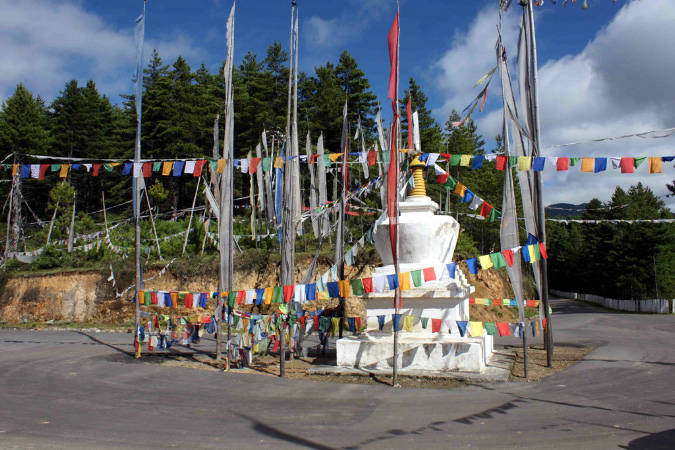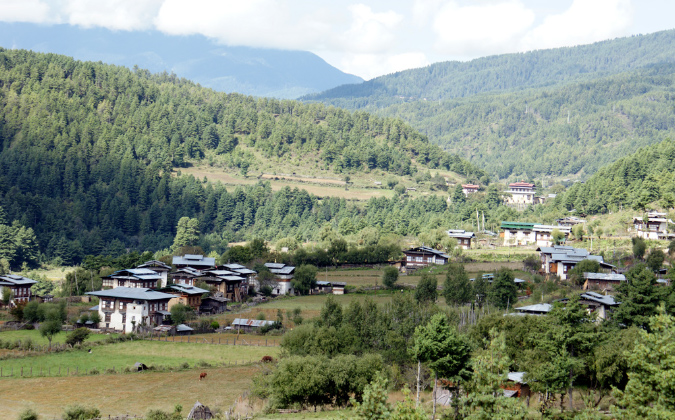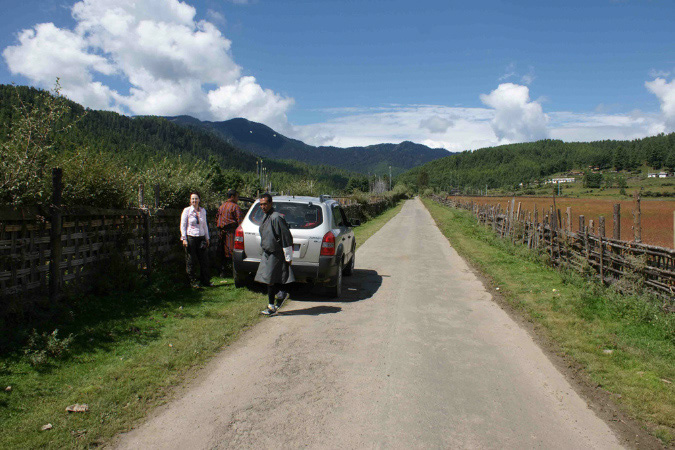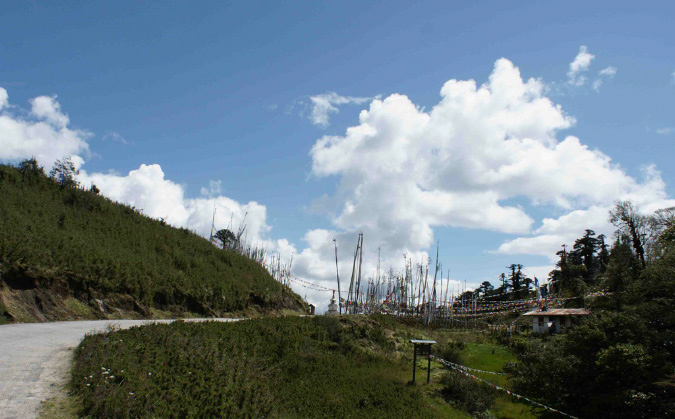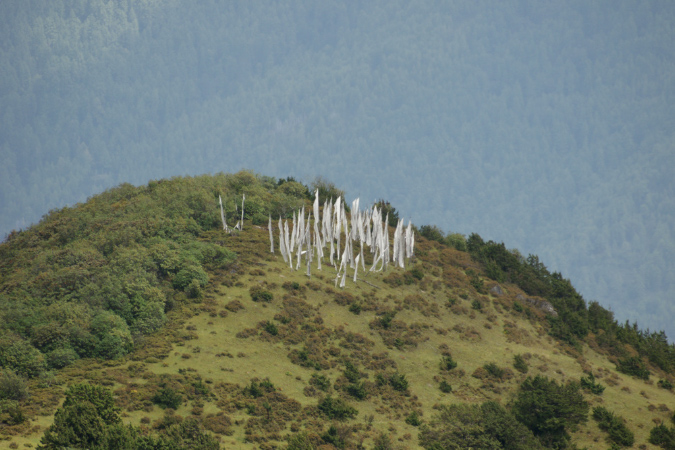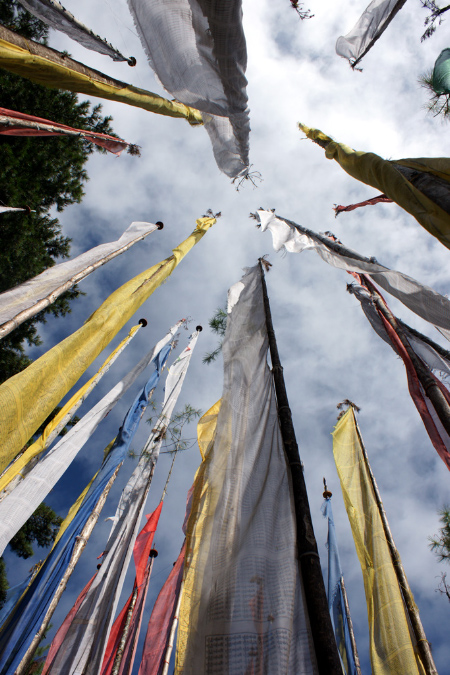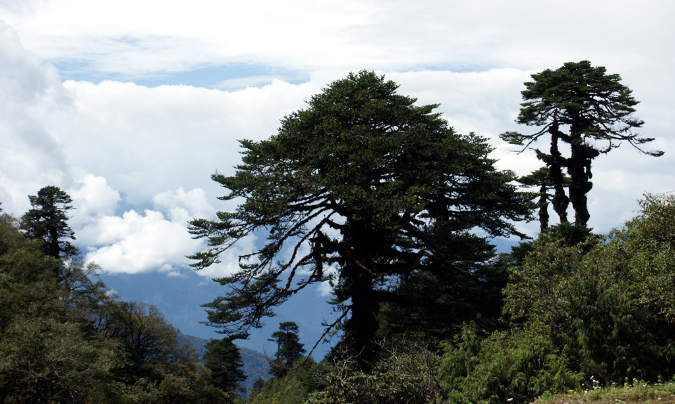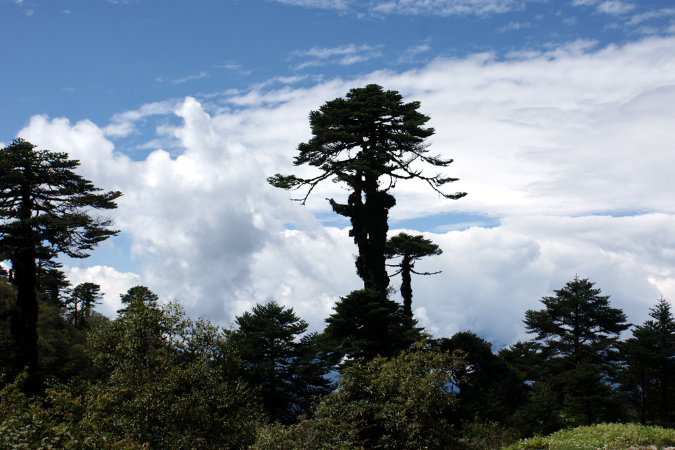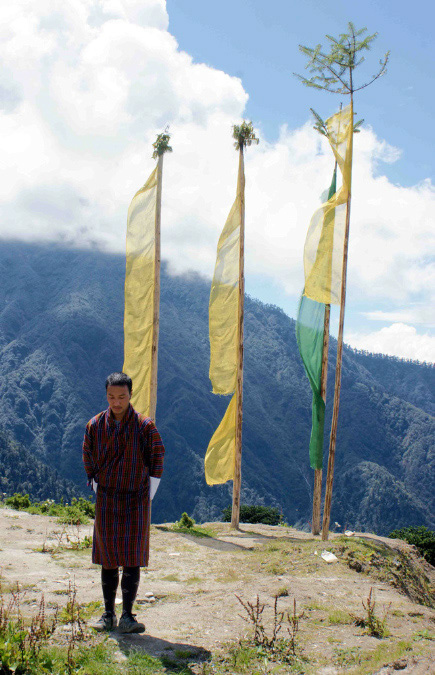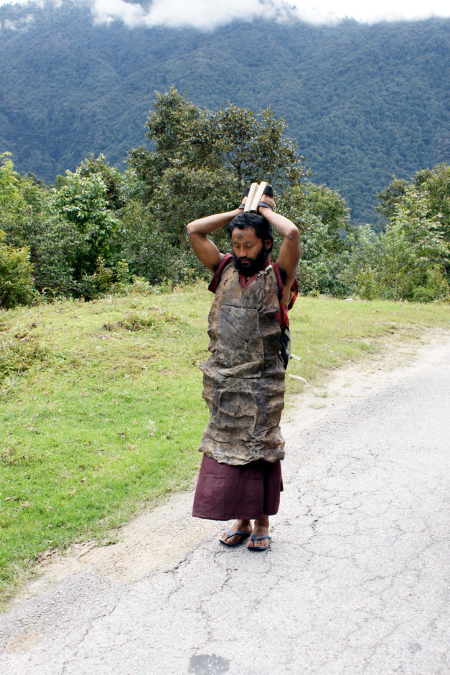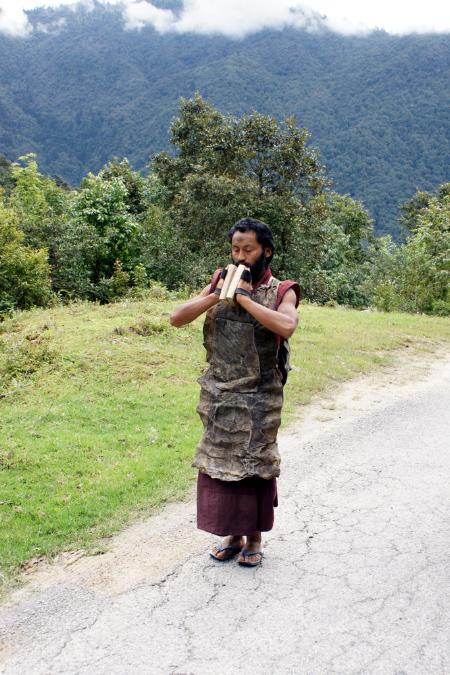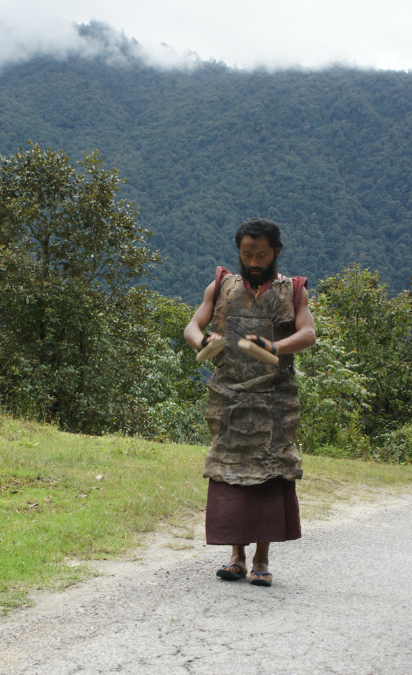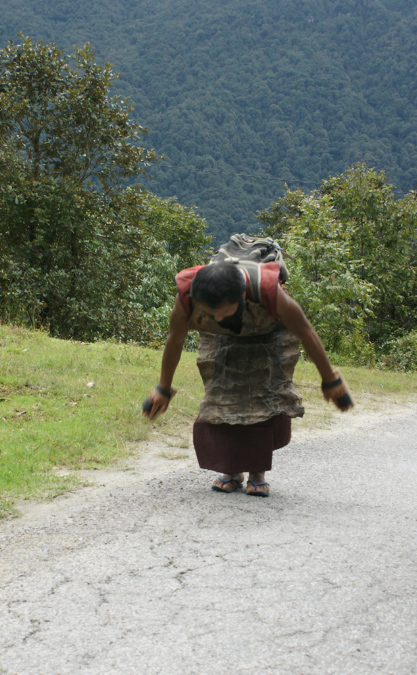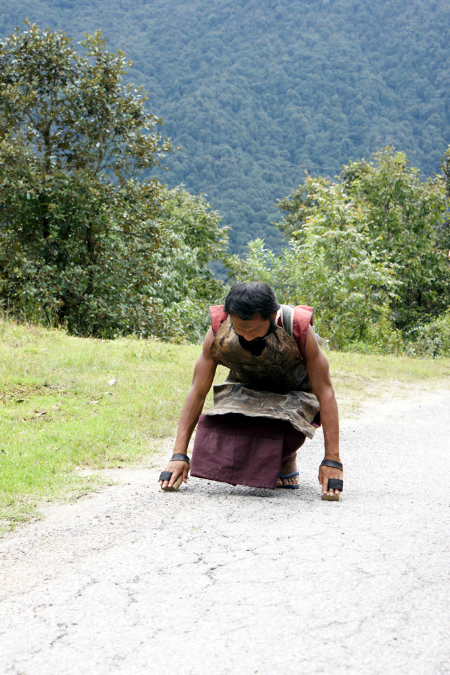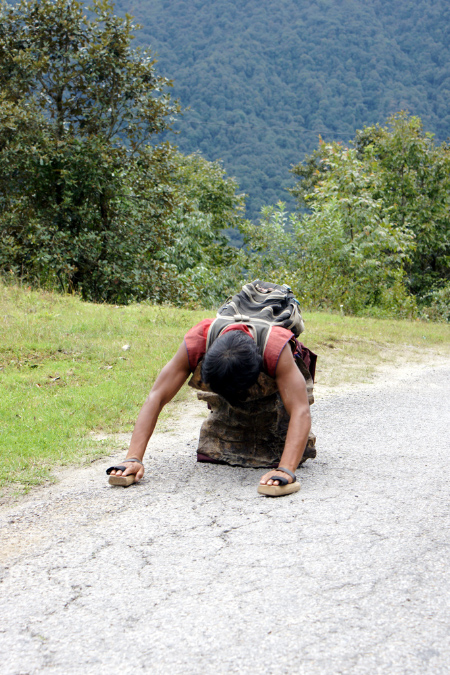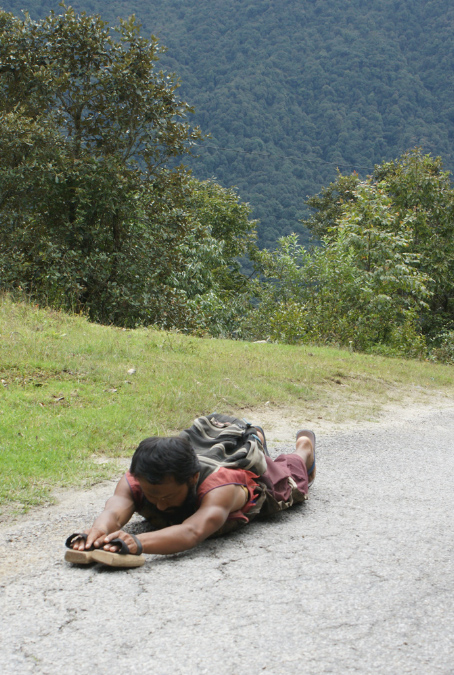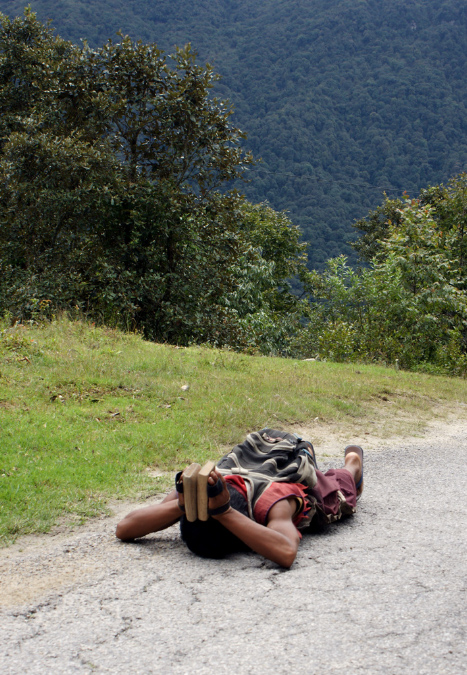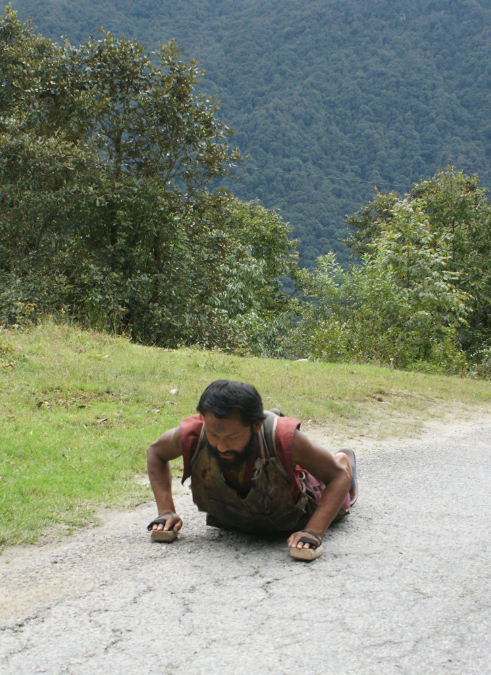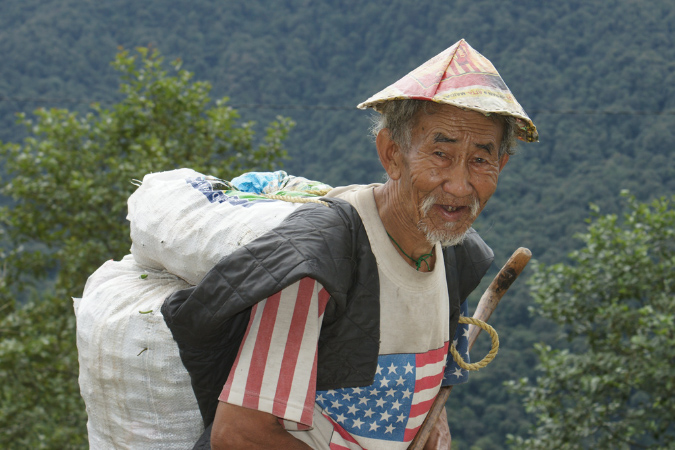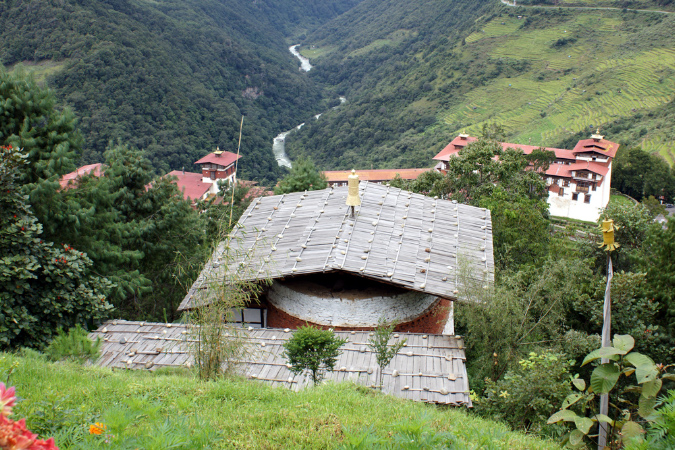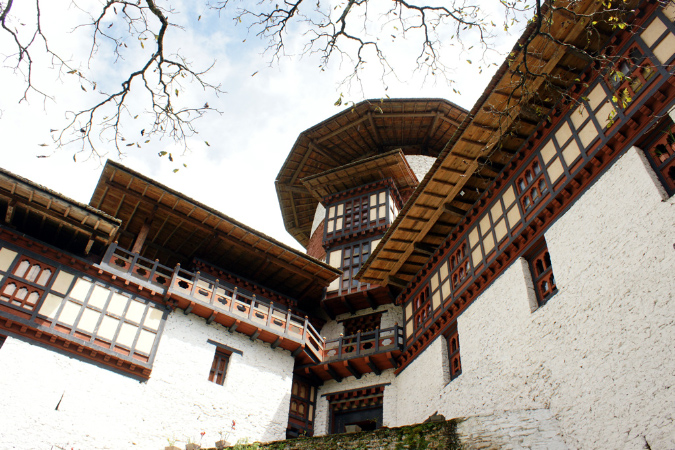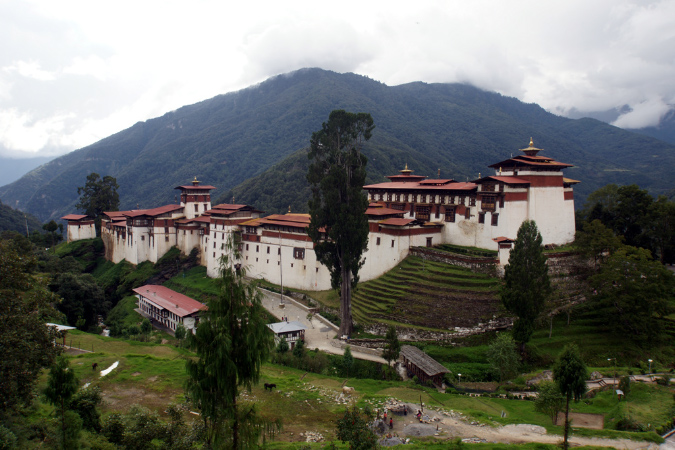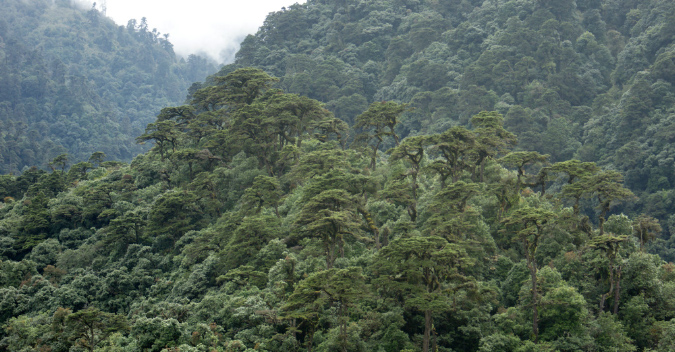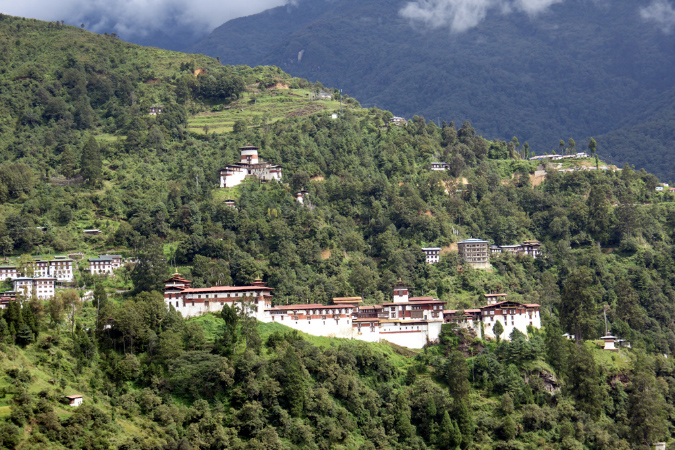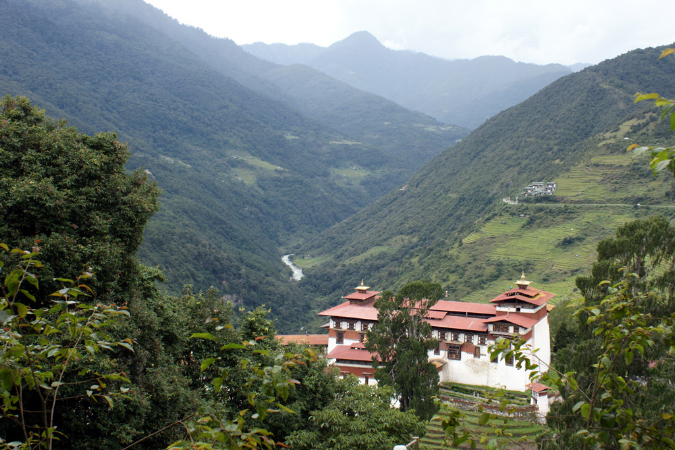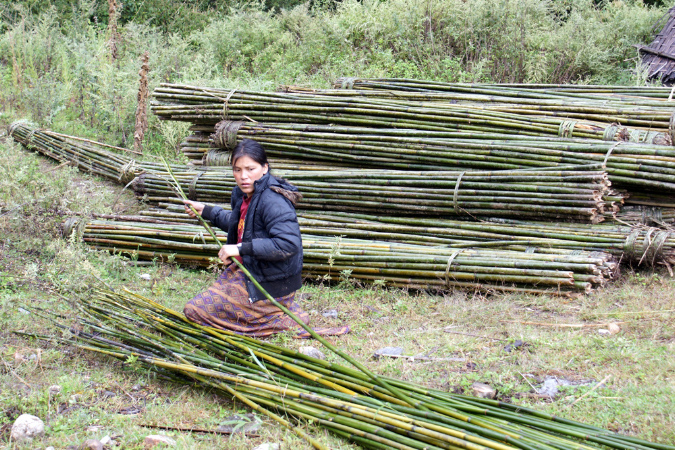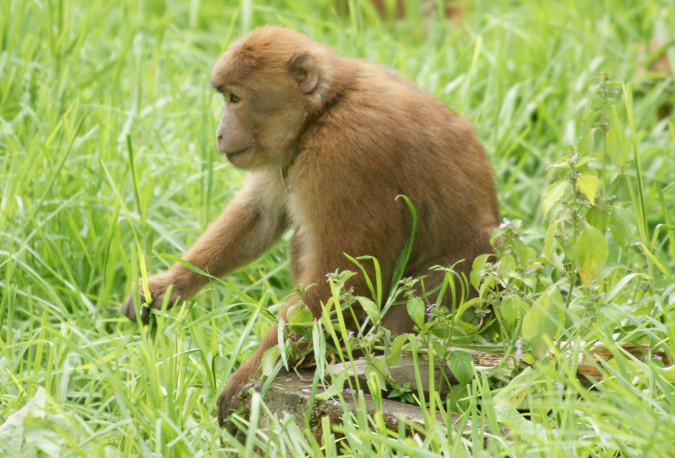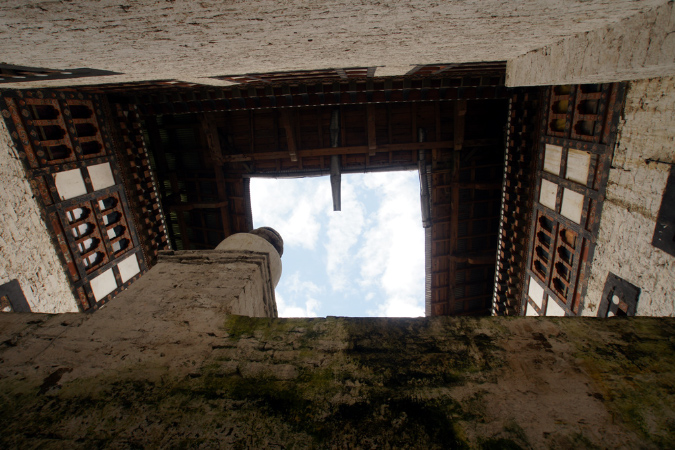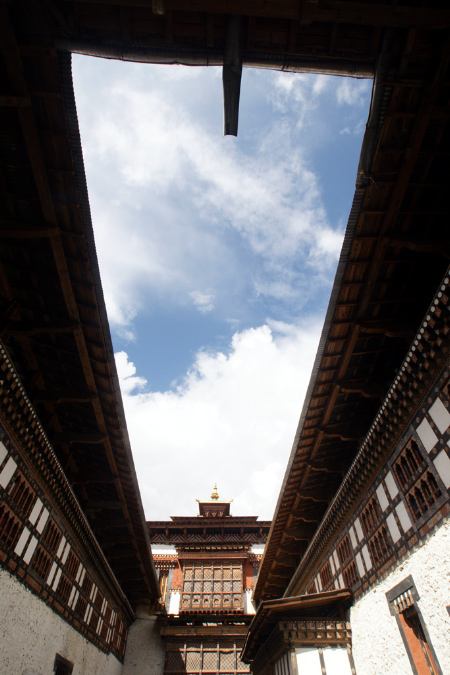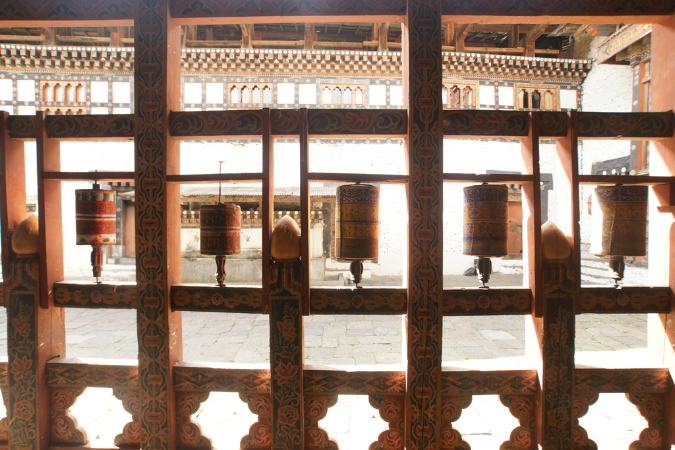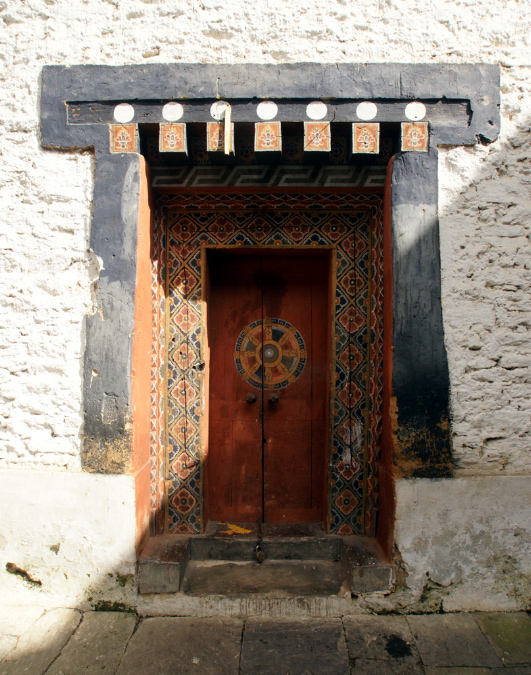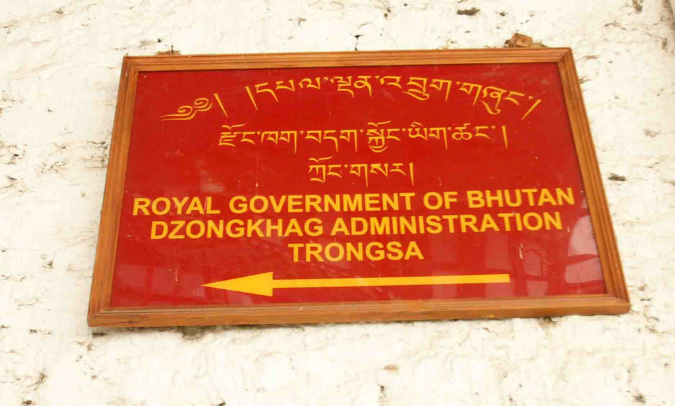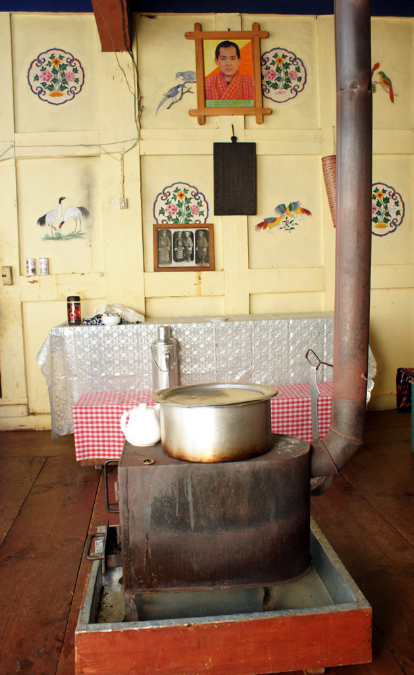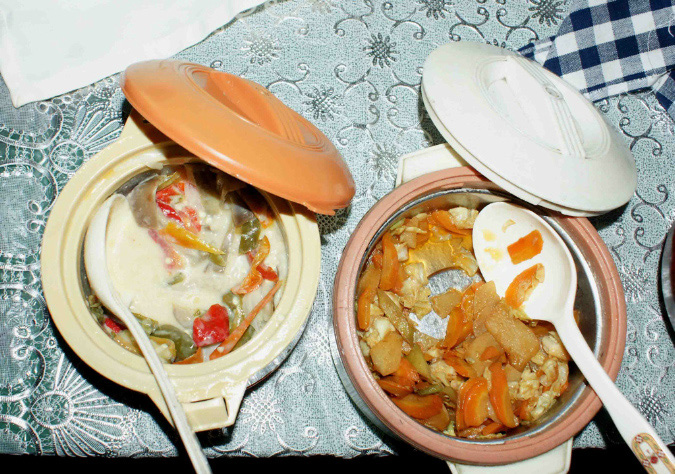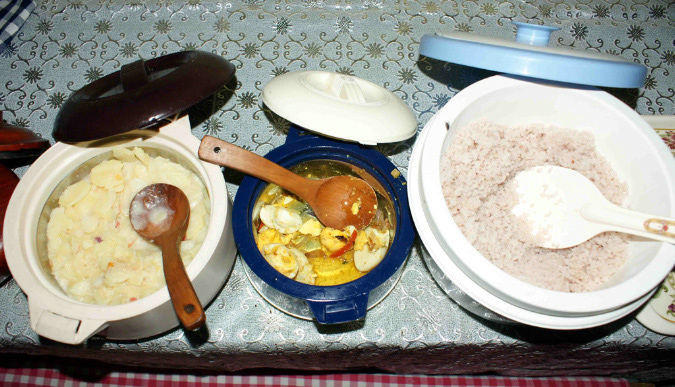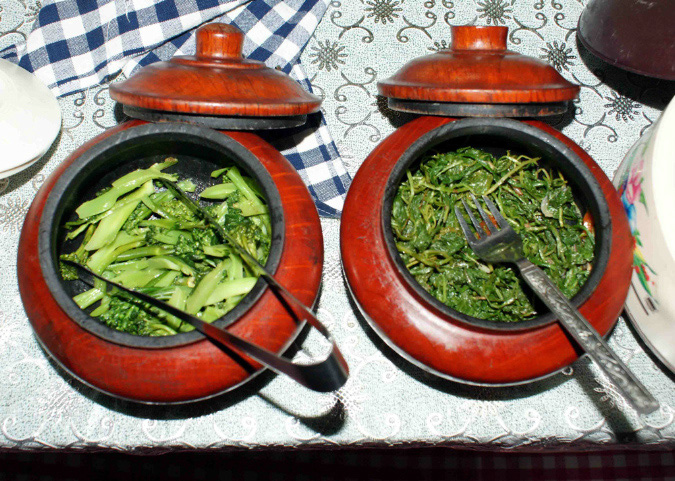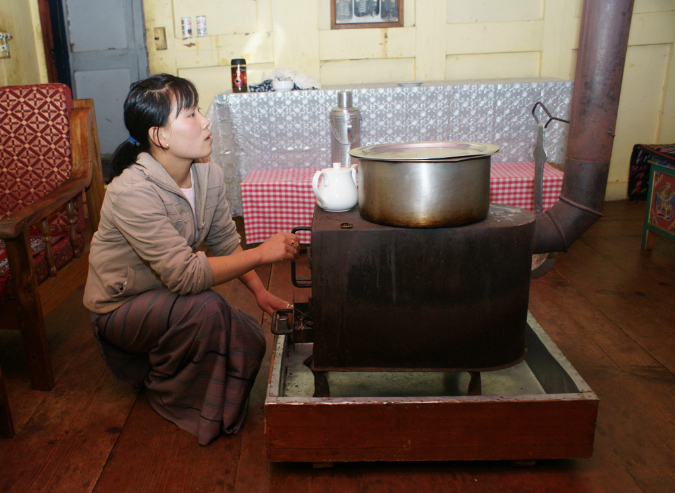|
Sir Ugyen Wangchuk, the first ruler of Bhutan was the Penlop at
Trongsa before he was crowned the King of Bhutan in 1907. However, he
retained the position of Penlop as well.
In
1652,
Minjur Tempa, the then Penlop of
Trongsa, had the dzong enlarged. In 1715, the Penlop Druk Dendrup built
the
Chenrezig (Avalokiteshvara) Lhakang and in 1765, Penlop Zhidar
established a monastic community of around 50 monks at the dzong. In
1771, a whole complex, including the Maitreya (Jampa) temple was added
to provide for the monks. In 1853, the 10th Penlop of Trongsa, Jigme
Namgyal, who was the father of the first king. erected the Demchog (Cakrasamvara)
Lhakhang, in the central section of the dzong.
Trongsa
Dzong was heavily damaged following the
1897 Assam earthquake. It underwent major repair and was restored by
both the 1st king, Ugyen Wangchuck and the 2nd king,
Jigme Wangchuck in 1927, who renovated the Chenrezig Lhakhang in
particular. In 1999, funding from
Austria led to extensive restoration works and was reconsecrated in
October 2004, coinciding with the enthronement of the Crown Prince.
The old
village of Trongsar is located below, but there is a new village of
Trongsar which has been under construction on the mountainside since
1982. Tibetan immigrants came to the valley in late 1950s and early
1960s and settled down here. The shopkeepers here are mainly of
Bhutanese and
Tibetan origin.
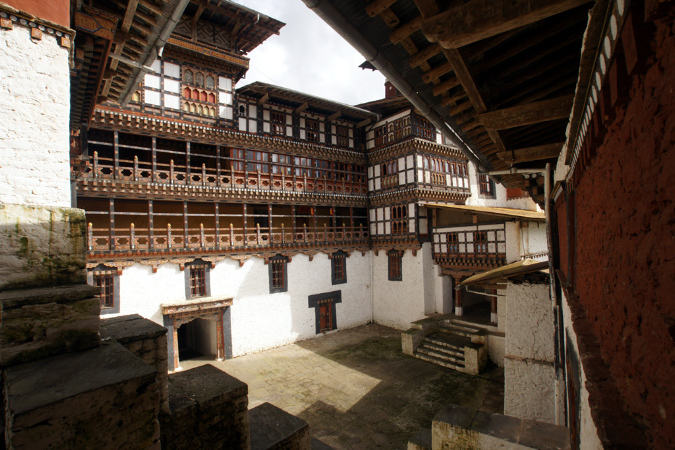
Architecture
Trongsa
Dzong is a powerfully built fortress and is exemplary of
dzong architecture. The Trongsa Dzong is an extensive complex; the
largest in all of Bhutan, and is set on many different levels. It
consists of a maze of courtyards, passageways and corridors and the
complex contains as many as 25 temples.
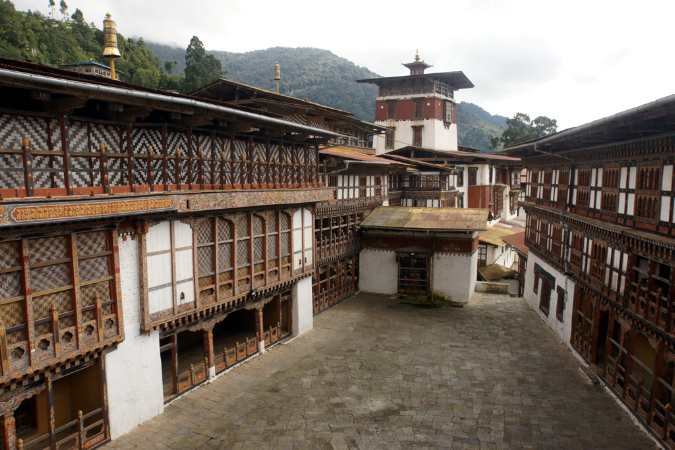
The
most important temples are those which were dedicated to the
Tantric deities of
Yamantaka,
Hevajra,
Cakrasamvara and
Kalacakra. The
Maitreya (Jampa) temple was erected in 1771 and today contains a
clay statue of the Buddha of the Future, donated by King Ugyen Wangchuck
in the early 20th century. The Temple of Chortens is located on the spot
where the original 1543 temple had stood. It contains the funerary
chorten of Ngagi Wangchuk and has 16 paintings of the
Arhats and of the Buddha
Akshobhya (Mitrugpa). The watchtower of the fortress, named Ta Dzong,
towers above the gorge to the east side of the dzong.
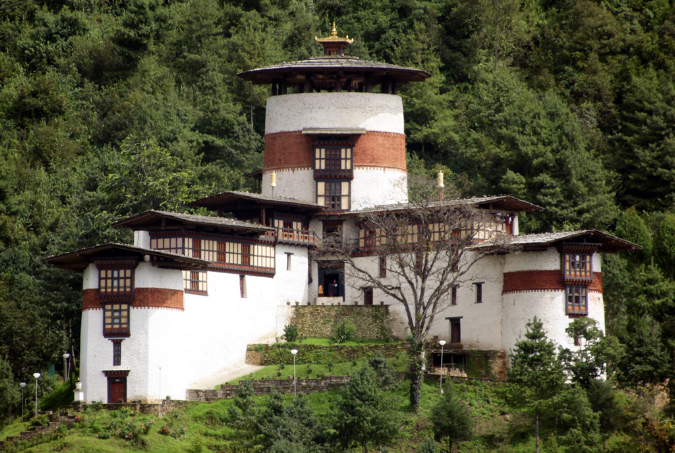
The
watchtower is narrow and has two wings which project in a v-shape from
the main part of the building. It also contains a temple, established in
1977 to honour the warrior god,
King Gesar. In 2008, a museum was added to this complex, following
Austrian donations. The interior decorations in the temples are
attributed to the time of the reign of the first ruler, king
Ugyen Wangchuk. However, the Dzong has undergone renovations in
recent years with assistance provided by an Austrian team. The original
design of the northern assembly hall, an original court scene with mural
paintings of the guardians of four directions,
Phurba statue in the main hall , a mural replica of
Swayambunath temple of Nepal and a pictorial map of
Lhasa are retained.
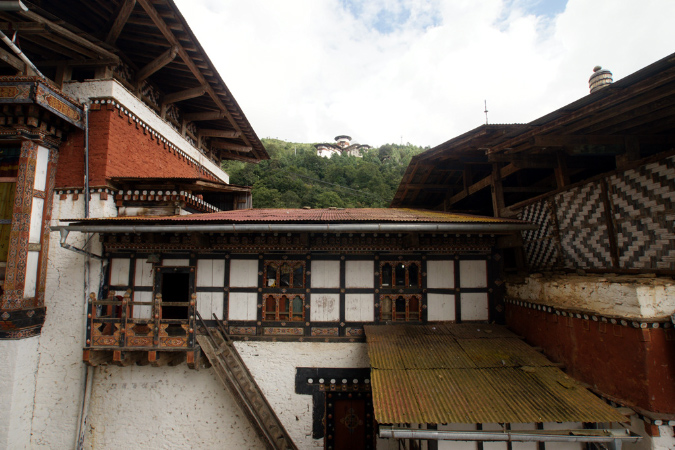
Ta
Dzong, the watch tower, that was in the past a stronghold against
internal insurgencies, towering over the east side of the dzong, has
since been converted into a state-of-the Art Museum (National Museum)
with technical and financial support provided by Austria. The tower also
houses a chapel dedicated to the Jigme Namgyal who was penlop in the
19th century. It is also stated that in the dungeon of the tower two
British soldiers were imprisoned during the
Duar War. The Ta Dzong tower was originally a highly fortified six
storied tower with numerous galleries within the thick walls which acted
as a defence measure. Further fortifications in the form of three
independent towers were added at a higher elevation in close vicinity of
the Ta Dzong.
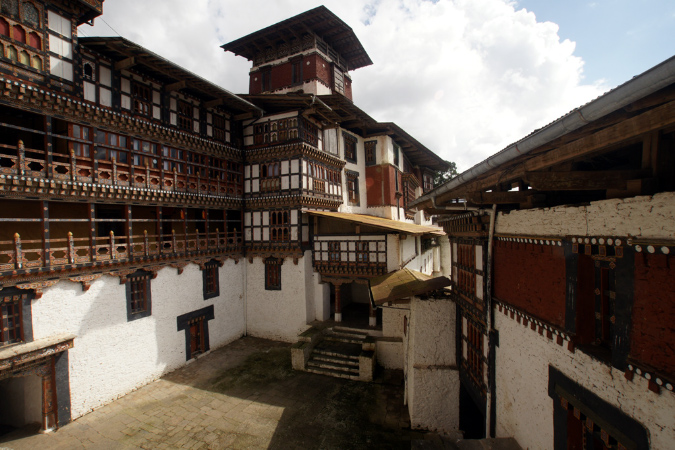
Aside
from its central administrative offices, Trongsa is a major monastery
and today houses around 200 monks.
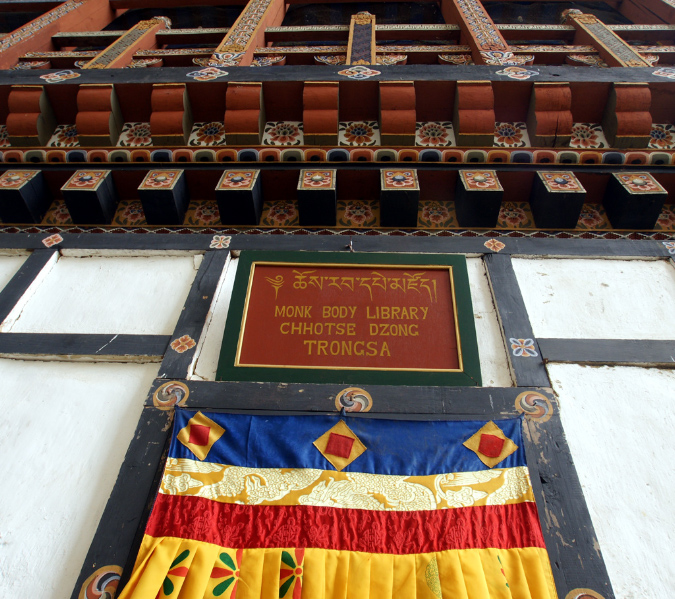
They
are also affiliated
Kurje Monastery in the Choekhor Valley of
Bumthang and some of them often spend their summers at Kurje. An
important printing house is also located at the dzong, where printing of
religious texts is done by traditional
woodblock printing.
Ein
letzter Blick zurück:

Unterwegs
kamen wir noch an dieser Stupa vorbei:
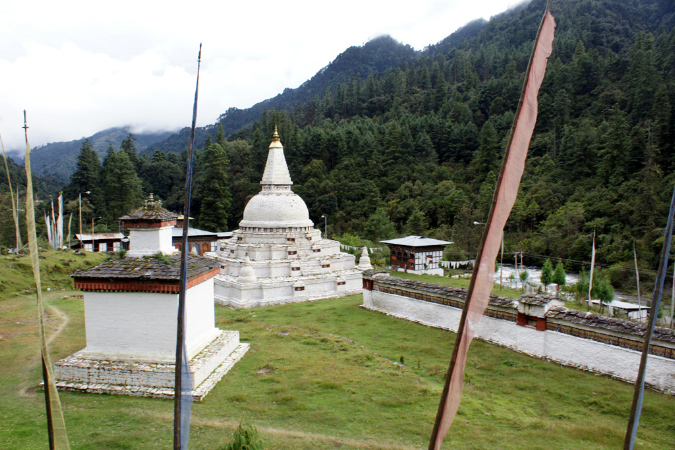
Chendebji Chorten
Just 2 Km. from Chendebji is the Chendebji Chorten, a large white
structure built in the style of Swambunath in Kathmandu to subdue evil
spirit killed at this place.
CHENDEBJI CHHOETEN is patterned after Swayambhunath in Kathmandu
(Nepal). The proper name is "Chorten Charo Kasho". The choeten was built
in 19th century by Lama Shida. Chendebji Chorten is 41km away from
Trongsa, just 2km beyond Chendebji village.
----------------------------------------------------------------------------------------------------------------------------
Auszug aus der Wikipedia
Stupa
Der Stupa
(Sanskrit: m., स्तूप, stūpa,
Pali: thupa, Tibetisch: mchod-rten, Chörten, im Deutschen ist auch
gebräuchlich: „die Stupa“
f, ältere englische Bezeichnung „Tope“, daher Topen) ist ein
Denkmal, ein Symbol für den
Buddha und den
Dharma. Ein Stupa ist ursprünglich ein Grabhügel für die Bestattung
von Königen in
Indien und reicht bis in die prähistorisch-megalithische Zeit
zurück. Seit dem frühen Buddhismus werden in einem Stupa Reliquien des
Buddha und später von herausragenden Mönchen (Arhat)
aufbewahrt.[1]
Er wurde Ausgangspunkt der Buddha- und Arhatverehrung.[1]
Der Stupa wird von Buddhisten rituell im Uhrzeigersinn
Wortgeschichte
Die englischsprachige
Fachliteratur des 19. Jahrhunderts bezeichnete den Stupa auch als
„Tope“. Der Begriff soll aus Afghanistan stammen, wo
Johann Martin Honigberger und Charles Masson 1833 buddhistische
Monumente, solide gemauerte Grabhügel, entdeckten (die „Kabul Minars“),
die sie Topes nannten. Der gleiche Begriff wurde auch für die Grabhügel
von Manikyala im
Punjab benutzt, daher kommt
Alexander Cunningham in seinem Buch The Bhilsa Topes zu der
Schlussfolgerung, dass Tope vom
Pali-Wort Tupo stammt, welches wie auch das Sanskrit-Wort Stupa
einen Grabhügel („Tumulus“) beschreibt.
Geschichte des Stupas
Vorbuddhistischer Ursprung
Mit Stupa war in uralten
Zeiten der Erdhügel gemeint, der über den Überresten einer toten Person
errichtet wurde (aus dem
Sanskrit stup: aufhäufen, ansammeln). Dieser Hügel hatte die Form
einer Halbkugel und war meist aus Erde oder auch aus Stein gemacht: die
Inder setzten einen Stab in den Mittelpunkt der Halbkugel und
beerdigten die Gebeine unter ihm. Der Stab wurde als Verbindung zum
Zentrum des Universums angesehen, welches alle Energie sammelte und die
Geburt allen Lebens beeinflusste. Die (Halb-)Kugel als Symbol für
Vollständigkeit zeigte die Balance von Energie im Universum, wurde zum
Symbol des Universums.
Erste Stupas im Buddhismus
Diese Idee übernahm später
der Buddhismus. Stupas gelten als die ersten wichtigsten Denkmale und
Orte künstlerischer Gestaltung im Buddhismus. Der Buddha soll den Bau
von buddhistischen Stupas angewiesen haben, allerdings sind die ältesten
bekannten Stupas aus der Zeit Kaiser
Ashokas. Dieser ließ einer Legende nach 84.000 Stupas in seinem
Herrschaftsgebiet errichten.[4]
In der Mahaparinibbana-Sutra
wird erwähnt, dass vier Personenkreise würdig genug sind, einen solchen
Grabhügel zu erhalten: Ein Vollendeter, ein Heiliger, „vollkommen
Erwachter“ (also ein historischer Buddha – Samma-Sambuddha), ein
„einzeln Erwachter“ (also ein Buddha, der allerdings nicht den
Dharma predigt – Pacceka-Buddha), ein Jünger des Vollendeten und ein
Kaiserkönig (Chakravartin – Universeller Monarch).
Symbolische Bedeutung
Ausbildung eigener Formensprache
In nur wenigen
Jahrhunderten entwickelte sich der schlichte Grabhügel zu der Grundform
der heutigen Stupas, der
Stupa von Sanchi (Zentral-Indien). Bereits hier sind die vier
Grundelemente zu erkennen: eine quadratische Plattform als Basis, das
halbkugelige Kuppelgewölbe, eine Reliquien-Kammer, die Spitze, oft auch
durch einen stilisierten Schirm ersetzt, die mit einer „Krone“, einem
„Juwel“ (welches oft wörtlich zu nehmen ist) abgeschlossen ist. Diese
vier Elemente stehen für die Elemente des Buddhismus: den
Sangha (Basis), das
Dhamma (die Kugel), den
Buddha (die Reliquienkammer, die Spitze) und das
Nibbana (das Juwel).
Bedeutung
Der Stupa beinhaltet eine
mannigfaltige symbolische Bedeutung.
-
Der Grundriss des
Stupa kann ein Symbol sein für:
-
Der gesamte Stupa-Bau
kann ein Symbol sein für:
-
Die Kuppel des Stupa
kann ein Symbol sein für:
Reduziert man einen Stupa
auf seine wesentlichen geometrischen Bestandteile, erhält man von oben
nach unten folgende Symbolik:
|
2-dim. |
3-dim. |
Element |
|
„Juwel“ |
Raum |
|
Halbmond |
Halbkugel |
Luft |
|
Dreieck |
Kegel |
Feuer |
|
Kreis |
Kugel |
Wasser |
|
Quadrat |
Würfel |
Erde |
Bedeutung als Verwendung
des Stupa:
-
Der Stupa als
Reliquien-Behälter − Nach seiner Kremation wurden die Reliquien des
Buddha in acht Teile geteilt und an die acht anwesenden Könige
verteilt. Mehr als 200 Jahre später fanden sich auf wundersame Weise
diese acht Teile im Besitz von Kaiser
Asoka wieder. Der Legende nach teilte er sie daraufhin in 84.000
Teile und schloss sie in ebenso viele Stupas in seinem gesamten
Reich ein.[4]
Ausgehend von der Zahl der Stupas, die heute für sich in Anspruch
nehmen, Reliquien des Buddha zu enthalten, ist es recht
unwahrscheinlich, dass sie wirklich einen dieser 84.000 Teile
enthalten. Möglicherweise handelt es sich oft nur um Kopien von
solchen Stupas.
-
Der Stupa als Denkmal
(Sanskrit: uddesika-stūpa) − in der Mahaparinibbana Sutta
weist der Buddha auf vier Plätze hin, die Gläubige nach seinem
Eingehen ins
Parinirvana besuchen können. Hier sollten im Angedenken an die
Ereignisse Stupas errichtet werden: am Ort seiner Geburt (Lumbini),
am Ort seiner Erleuchtung (Bodhgaya),
am Ort der Ersten Predigt (Sarnath)
und am Ort seines Parinirvana (Kusinagara). Später wurde die Liste
der buddhistischen Pilgerstätten um weitere vier Orte erweitert:
Srāvastī, Sāmkāśya, Vaiśali und Rājagṛha.
In Tibet werden diesen acht Orten acht verschiedene Typen von Stupas
zugeordnet (siehe z. B. beim
Kloster Dzogchen in Kham).
-
Der Stupa als
Votivgabe:
-
Viele Stellen des
Mahayana-Kanons weisen darauf hin, dass es eine
verdienstvolle Tat ist, einen Stupa zu bauen. Damit werden bis
zu 18 verschiedene Arten von Verdiensten verbunden. Allerdings
sind beim Bau einige Dinge zu beachten. Es ist zwar gleich, in
welcher Größe man einen Stupa plant - wichtig sind jedoch
korrekte Proportionen und eine reine Motivation des Bauherrn.
Gemäß tibetischer Tradition muss ein kundiger Lama daher den Bau
überwachen und anschließend einweihen, um keine „Schwarze Stupa“
zu erhalten („wie ein Körper ohne Eingeweide“) Gefüllt wird der
Stupa mit sogenannten
Tsa-Tsas..
-
In Thailand ist es
Tradition, zu Neujahr (Songkran)
in den Tempeln Stupas (Chedis)
aus Sand zu bauen. Der Sand soll den Staub wieder an den
Ursprungsort zurückbringen, den die Gläubigen im Laufe des
Jahres an ihren Schuhen haftend von dort weggetragen haben.
Vorzüge
Eine Stupa zu errichten
gilt im Buddhismus als sehr heilsam, da positives
Karma im Geist des Erbauers zurückbleibt. Auch in der Zukunft seien
dem Baumeister dadurch vielfältige Vorzüge durch vorteilhafte
Wiedergeburten gegeben.[9]
Im besten Fall wird eine rasche
Erleuchtung ermöglicht. Eine Stupa zu umschreiten sei ebenfalls sehr
vorteilhaft und ermögliche positive Wiedergeburten.
Verschiedene Entwicklungen
Aus dem Stupa entwickelte
sich in
Sri Lanka seit dem 2. Jh. v.Chr. die Dagoba, in
Myanmar die Paya, in
Thailand die
Chedi, die auf der singhalesischen Dagoba fußt. Daraus ergab sich in
Laos der That.
Die nördliche
Entwicklungslinie zeigt in Ostasien die
Pagode, deren chinesische Variante innen begehbar ist. Die
chinesische Pagode verbreitete sich im 5.-8. Jh. nach Korea und Japan
(in Japan ausschließlich aus Holz konstruiert). In
Tibet entwickelte sich der Stupa zur
Chörten weiter, dessen Bauform in Texten des Tengyur, dem
Kommentarteil des tibetischen
buddhistischen Kanons, festgelegt ist. Der Chörten symbolisiert den
Stufenweg zur Erleuchtung und stellt zugleich ein Sinnbild für den
aktiven Weg des Bodhisattva dar.
----------------------------------------------------------------------------------------------------------------------------
Unterwegs - typisches
bhutanesisches Haus:
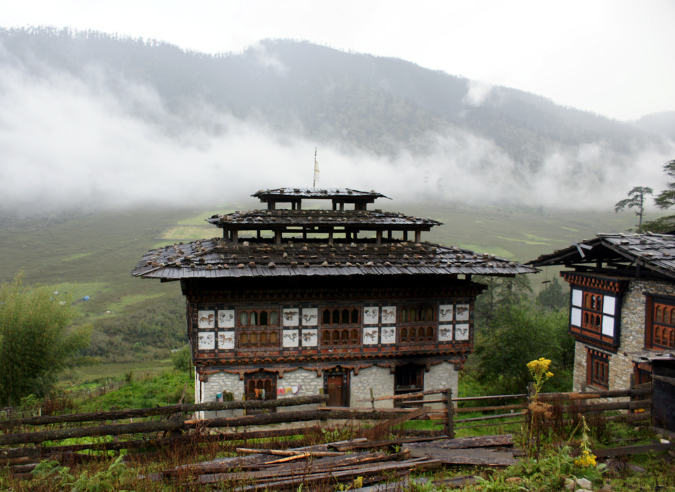
Traditional Bhutanese Houses
Traditional Bhutanese houses serve as a home or residential dwelling
for the family, a shelter for domestic livestock, a place for weaving
and other household activities and also a religious space. The
architecture of vernacular houses in Bhutan has an open or semi-covered
courtyard in front of the building, which is used to grow vegetables and
other agricultural produce, drying things, as a shelter for the animals
and other functions that are performed in the open. Most of the
indigenous rural houses are two or three stories high and each level has
a unique function. The ground floor is simply a space to keep animals,
the living quarters, the family room, the kitchen and the store find
their place on the first floor while the religious rituals are performed
in the upper storey, which is considered sacred.
Architectural elements and construction materials may vary a bit
according to environment and climatic conditions of a place. In most
houses in southern Bhutan, spaces are laid out in straight lines in
rectangular shapes and walls are either masonry or made up of
thick-rammed mud finished with plaster. They have ridged roof and inner
walls are made of closely woven bamboo matting. Traditional homes, in
the Bumthang area in central Bhutan, are made of stone and sparsely
decorated. You can see houses made of bamboo matting and built on stilts
in eastern Bhutan. Lungshi, Laya, Lunana yak herders and semi nomadic
people of northern Bhutan live in dry stone walled houses. Bhutanese
villages are often close hamlets of 5 to 15 houses, as a mutual
protection against the wind and cold. Trees are sometimes planted around
the village to act as windbreaks.
Typical Bhutanese houses found at altitudes of 1000 to 3000 meters have
timber frame structures assembled with a system of pegs. Glass panes are
rare in rural Bhutan and sliding wooden shutters are used instead to
close the window. The trefoil arches are striking and outer walls are
often painted black or brown with motifs such as clouds, lotus flowers
or other auspicious signs. Phallic images on the exteriors of Bhutanese
homes look startling against conservative Bhutanese background that are
painted or carved to chase away demons and bring fertility and
prosperity to the household. Elaborate cornices and wide overhanging
eaves adorn larger houses. Traditionally, the kitchens had no chimney
and smoke escaped through the windows, leaving a thick layer of soot
over everything. This protected the wood from insects.
----------------------------------------------------------------------------------------------------------------------------
Wir übernachteten auf einem Bauernhof in einem großen typischen
bhutanesischen Haus, das wir bei einbrechender Dunkelheit erreichten.
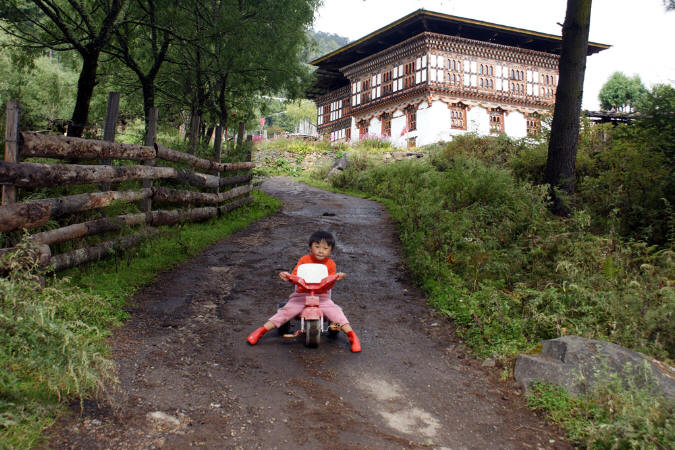
Man wartete schon auf uns. Wir hatten etwas gebummel, waren desöfteren
ein Stück zu Fuß gegangen, um die Landschaft intensiver erleben zu
können. Viel war auf den Straßen eh nicht los. Im Gegensatz zur
Hinfahrt, als sich alles wegen der Straßenabgänge zusammengedrängt
hatte, kam jetzt ganz selten ein Auto entgegen. Da unser Kommen
angekündigt war, und wir bereits Interesse an einem Steinbad bekundet
hatten, war das Feuer schon fast niedergebrannt und die Steine schon
heiß.
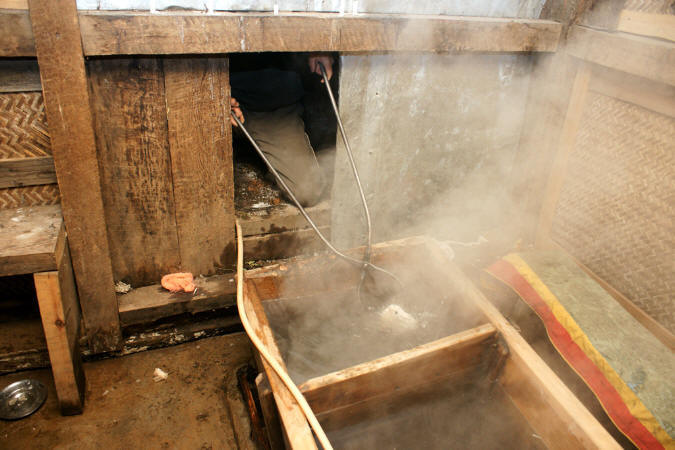
Das Steinbad ist die Form, wie sich die Bhutanesen ausgiebig waschen.
Also wie die Finnen in die Sauna gehen oder die Türken in den Hamam. Das
Steinbad ist ein Holzbottisch, der durch eine Holzwand in zwei
unterschiedlich große Teile getrennt ist. Im etwas kleiner Teil werden
die im Feuer erhitzten Steine mit einer Zange gelegt. Diese wärmen das
Wasser auf. Das warme Wasser wärmt das kalte Wasser, was sich in dem
größeren Abschnitt befindet, auf, indem es durch einen Schlitz unterhalb
der Trennwand dort hingelangt und ausgetauscht wird.
Im größeren Teil des Holzbottichs nimmt man das Bad. Mit der Zeit wird
das Wasser immer wärmer, da die Steine immer mehr Wärme abgeben. Das Bad
soll besonders gesund sein, da die Steine auch zum Teil ihre Mineralien
abgeben und diese gut für die Haut sind. Man muss daran glauben. Toma
machte es enorm viel Spaß. Für die Bhutanesen ist dies ein nicht
alltägliches Ereignis.
|
